 北京白云观是道教全真派三大祖庭之一,素有“天下道教第一丛林”之誉,始建于唐玄宗开元二十九年(公元741年),初名天长观,供奉太上老君,宋代改名太极宫。元初,邱长春真人应元太祖成吉思汗之诏掌管天下道教并赐居此观,易名长春宫。邱长春真人羽化后其弟子于长春宫之东侧建处顺堂藏其遗蜕。明初,长春宫毁于战火,唯处顺堂独存,朝廷曾几次颁旨重修,其修建工程以处顺堂为中心向四周扩展,更名为“白云观”。明英宗正统八年(公元1443年),英宗皇帝再次颁旨修缮并赐“敕建白云观”匾额。 自明清以来,北京就盛行在春节期间人们前来白云观参加庙会、拜本命神、摸石猴、打金钱眼等民俗活动。现今白云观的占地面积约六万平方米,建筑面积约一万平方米,共有十九座殿堂,分中、东、西三路及后院。其规模宏大、布局紧凑,为全国重点文物保护单位。中国道教协会、中国道教文化研究所、中国道教学院及《中国道教》杂志编辑部均设于此。 A Brief Introduction of Beijing Bai Yun Guan (White Cloud Temple) Beijing Bai Yun Guan is honored as the chief temple of the Three Ancestral Temples of the Quan Zhen(Complete Reality) Taoist tradition. It was originally called Tian Chang Guan (Heavenly Eternal Temple) and built in the twenty-ninth year of Kaiyuan (741A.D.) under the regime of Emperor Xuanzong in the Tang Dynasty in which Tai Shang Lao Jun is enshrined who was incarnated as the philosopher Laozi. It was renamed Tai Ji Gong in the Song Dynasty. At the beginning of the Yuan Dynasty, the Master Qiu Chang Chun was summoned by the emperor Genghis Khan to preside over all the Taoists in China and to live at this Temple so it was renamed Chang Chun Gong. After Qiu Chang Chun ascended to heaven as an immortal, his disciples built a deity hall (named Chu Shun Tang) to conceal his physical body, and enshrine him beside Chang Chun Gong in the east. At the beginning of the Ming Dynasty, the Temple was ruined by battles and nothing remained except the Chu Shun Tang, so the imperial government issued orders to rebuild the temple several times and renamed it Bai Yun Guan. The rebuilding expanded around the center of Chu Shun Tang. In the eighth Zhengtong Year (1443A.D.) under the regime of Emperor Ying Zong in the Ming Dynasty, the Emperor ordered to renovate and rebuild it again and conferred an iron placard inscribed with the words “Chi Jian Bai Yun Guan”, which meant the White Cloud Temple was built by imperial order. Since the Ming and Qing dynasties, every Spring Festival, most local people come here to enjoy the temple fair, worshiping one’s destiny deity, touching stone monkeys, hitting the golden coin’s eye, etc. At present this temple covers an area of approximately 60,000 square meters, including all the constructions which cover about 10,000 square meters. It consists of an east area, a middle area, a west area and a rear garden. There are 19 deity halls well laid out in the east, west and middle sections. It has been listed as a historical site under the protection of the Chinese government and it houses the Chinese Taoist Association, the Institute of Chinese Taoist Culture, the Chinese Taoist College and the Editorial Department of The Journal of Chinese Taoism. 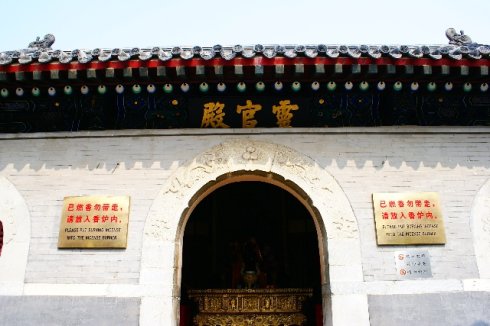 灵官殿 始建于明英宗正统八年(公元1443年),殿内主供道教护法神王灵官(王善),殿内两侧墙壁上有赵公明、马胜、温琼和岳飞四位护法元帅陪享。 王灵官,赤面、三目、披甲执鞭,位列道教护法神之首,纠察天上、人间之善恶,有驱邪治病之神通。 灵官圣诞:农历六月二十三日 Ling Guan Deity Hall This deity hall was originally built in the eighth Zheng Tong Year under the regime of Emperor Ying Zong in the Ming Dynasty(1443A.D.) and enshrined the tutelary deities in Taoism. The central one is Wang Ling Guan. Hanging on the side walls are portraits of four marshals from different periods of Chinese history, namely Zhao Gong Min, Ma Sheng, Wen Qiong and Yue Fei. Wang Ling Guan has a red face and three eyes, wears a gold armor and holds a steel whip in one hand. He is the chief tutelary deity in Taoism who can exorcise evils in the heaven and on earth and helps patients recover from illness. His birthday is on June 23 of the lunar calendar. 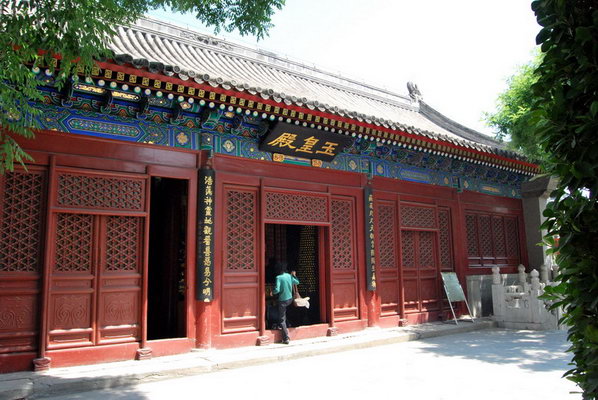 玉皇殿 始建于明英宗正统三年(公元1438年),门上匾额为1956年国家副主席李济琛所书, 殿内幔帐为清代慈禧太后所赠。 殿内供奉昊天金阙至尊玉皇大帝,众神之王, 总管三界、十方、四生、六道的一切阴阳祸福。 玉皇圣诞:农历正月初九日 Yu Huang Deity Hall This deity hall was initially built in the third Zheng Tong year under the regime of Emperor Ying Zong in the Ming Dynasty (1438A.D.). The words on the board above the gate were written by the vice chairman of Chinese government Li Jichen in 1956. The drapery in the hall was conferred by the Queen Mother Ci Xi in the Qing Dynasty. Enshrined here is the Jade Emperor who is the Master of all deities, presides over the heaven, the earth and the nether world, and controls all the happiness and the disasters. His birthday is on January 9 of the lunar calendar. 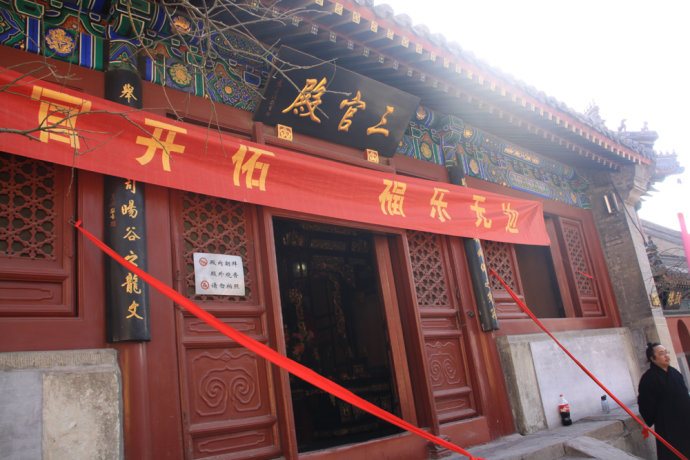 三官殿 殿内供奉三官大帝,即天、地、水三官。天官赐福降祥,济民救苦;地官赦除过咎,解释冤愆;水官解脱疾厄及一切灾难。三官的圣诞称为三元节,即上元(天官)正月十五日、中元(地官)七月十五日、下元(水官)十月十五日。 San Guan Deity Hall Enshrined here are three celestial officials, namely the Official of Heaven, the Official of Earth and the Official of Water. The Official of Heaven can bestow happiness on people, the Official of Earth can absolve people from their sins and the Official of Water can remove disaster from people. The Official of Heaven’s birthday is on January 15 of the lunar calendar; the Official of Earth’s birthday is on July 15 of the lunar calendar; the Official of Water’s birthday is on October 15 of the lunar calendar; the three days are well-known among Chinese people. 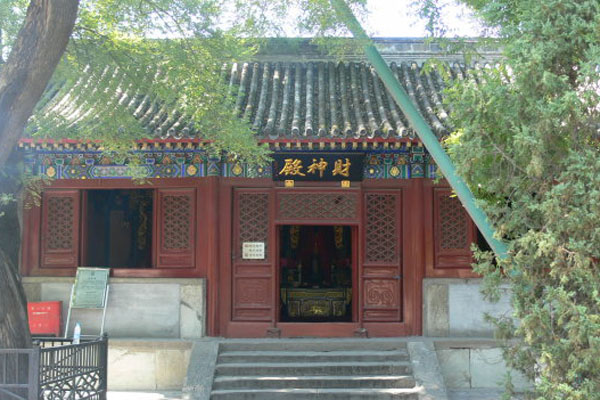 财神殿 殿内供奉三位财神。中间为文财神比干,左为武财神赵公明元帅,右为武财神关圣帝君。善信祈求,皆能财运亨通,仁义生财,有求必应。 文财神比干圣诞:农历正月初五日,赵公元帅圣诞:农历三月十五日,关圣帝君圣诞:农历六月二十四日。 Chai Sheng Deity Hall Enshrined here are three Wealth Deities. The one in the middle is the Literary Wealth Deity Bi Gan, the left one is the Military Wealth Deity Zhao Gongmin, and the right one is the other Military Wealth Deity Guan Yu. They can make business prosperous, and help kindhearted people make money quickly. They never refuse to respond to a prayer. Bi Gan’s birthday is on January 5 of the lunar calendar, Zhao Gongming’s birthday is on March 15 of the lunar calendar and Guan Yu’s birthday is on June 24 of the lunar calendar. 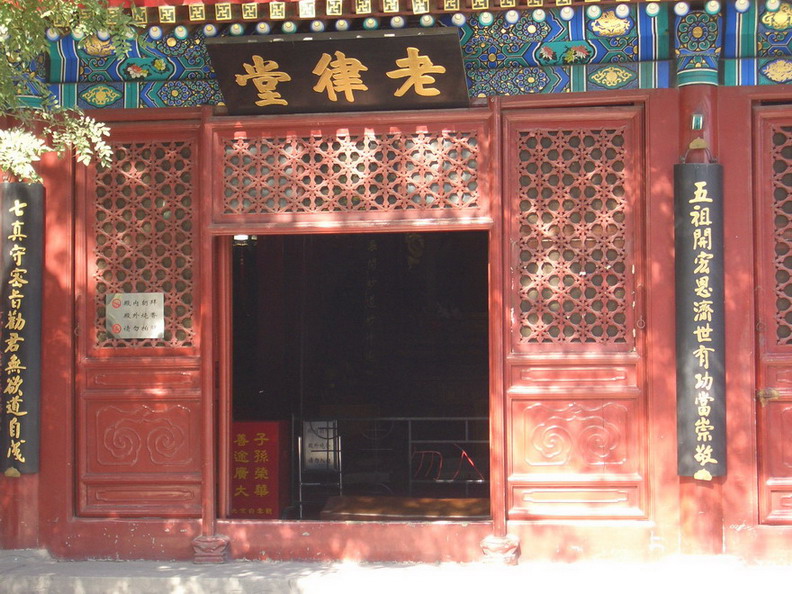 老律堂 原名“七真殿”,始建于元拖雷监国时(公元1228年),殿内供奉马丹阳、谭处端、刘处玄、邱处机、王处一、郝大通、孙不二七位全真祖师,因清代于此举行传授戒律仪式,故称“老律堂”,现为白云观道众日常诵经和举行祈祥法事的殿堂。 Lao Lv Tang(Ancient Discipline Hall) It was initially built in the year of Tuolei’s Administration (1228A.D.) in the Yuan Dynasty and called Seven True Saints Hall. It enshrined the seven Quanzhen Immortals in Taoism, namely Qiu Chuji in the middle, Liu Chuxuan, Tan Chuduan and Ma Yu in the east, and Wang Chuyi and Hao Datong and Sun Bu'er in the west. As in the Qing Dynasty, ceremonies of ordination were held here and the senior Taoist taught the Taoist disciplines in it, later it was renamed Lao Lv Tang (Ancient Discipline Hall). Now it is the hall for Taoists to chant daily scriptures, hold prayers and perform Taoist Rites.  药王殿 殿内供奉三位药神,中间药王孙思邈,左边神医华佗,右边医圣张仲景,皆为中国历史中的医药祖师。虔诚祈祷能使人沉疴自痊,健康长寿,世称三位皆有起死回生之神通。 药王圣诞:农历四月二十八日,神医圣诞:农历四月十八日,医圣诞辰:农历正月十八日。 Yao Wang Deity Hall Enshrined in this hall are three immortals in medicine.The central one is Medicine King Sun Simiao; the left one is Medicine Deity Hua Tuo; the right one is Medicine Sage Zhang Zhongjing. They are distinguished doctors in Chinese history who enable dying people to recover from illness quickly. There is a saying that they can revive the departed. Medicine King’s birthday is on April 28 of the lunar calendar, Medicine Deity’s birthday is on April 18 of the lunar calendar and Medicine Sage’s birthday is on January 18 of the lunar calendar. 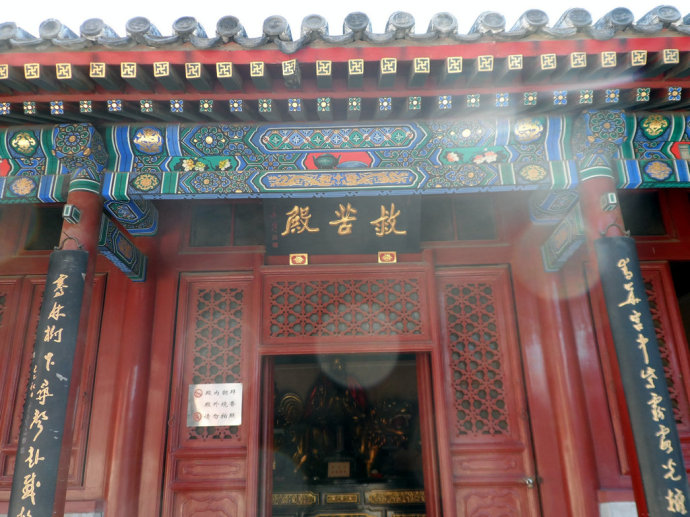 救苦殿 殿内供奉太乙救苦天尊,为九幽地府至高尊神,心性慈悲,普济沉魂滞魄,赦免种种罪愆,能使幽魂得睹光明、俱获超升。 救苦天尊圣诞:农历十一月十一日 Jiu Ku Deity Hall This deity hall enshrines Tai Yi Jiu Ku Tian Zun who is the Celestial Lord of Savior. He reigns over all the deities in the Taoist realm of nether world. With a merciful heart, he saves all souls of the dead, absolves people from all kinds of sin, and enables the souls to see the light and get reincarnation. His birthday is on November 11 of the lunar calendar. 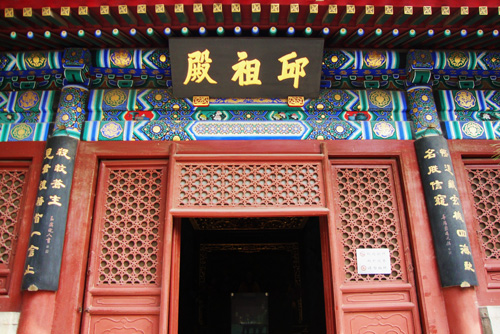 邱祖殿 始建于元代(公元1228年),原名“处顺堂”,殿内供奉邱长春真人,两侧为邱祖应诏西行、赴雪山会见成吉思汗的悬塑。祖师邱长春又名邱处机,为全真龙门派的创始人。殿内“瘿钵”为乾隆皇帝御赐之物,邱祖遗蜕藏于“瘿钵”之下。 邱祖圣诞:农历正月十九日 Qiu Zu Deity Hall It was initially built in the Yuan Dynasty (1228A.D.) and called Chu Shun Tang where True Saint Qiu Changchun is enshrined. The sculptures hanging on the side walls are showing the story of True Saint Qiu went to meet Emperor Genghis Khan after he received several invitations. Qiu Changchun, who is also named Qiu Chuji, is the founding father of the Long Men(Dragon Gate) sect of Quan Zhen(Complete Reality) Taoist tradition and therefore he is called Qiu Zu (Ancestor Qiu). The huge donation collecting bowl called “Ying Bowl” was conferred by Emperor Qianlong in Qing Dynasty, Ancestor Qiu’s physical body was concealed beneath the bowl. His birthday is on January 19 of the lunar calendar.  四御殿 建于明宣宗宣德三年(公元1428年),供奉四位协助玉皇执掌天道的尊神:中天紫微北极大帝,协助玉皇执掌天经地纬、日月星辰及四时气候;南极长生大帝,协助玉皇执掌人间寿夭福祸;勾陈上宫天皇大帝,协助玉皇执掌南北两极与天地人三才及人间兵革之事;承天效法后土皇地祗,协助玉皇执掌大地河山及阴阳生育。 Si Yu Deity Hall It was built in the third Xuande Year (1428A.D.) under the regime of Emperor Xuan Zong in the Ming Dynasty, and enshrined the four celestial lords who are prime ministers for the Jade Emperor, namely Zhongtian Ziwei Beiji Celestial Lord who presides over the sun, moon, stars and climate; Nanji Changsheng Celestial Lord who controls people’s disaster, happiness and the length of their life; Gouchen Shanggong Tianhuang Celestial Lord who presides over military in heaven and earth; Chengtian Xiaofa Houtu Huangdiqi Celestial Lord who presides over mountains , rivers and the births of all creatures on earth. 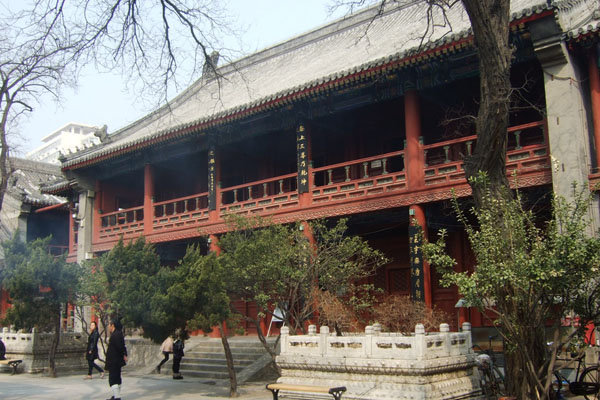 三清阁 始建于明宣宗宣德三年(公元1428年),殿内供奉道教最高尊神,正中为玉清元始天尊;左为上清灵宝天尊;右为太清道德天尊(又称太上老君)。三清皆属“道”的化身,分别为宇宙形成的三大世纪。 元始天尊圣诞:冬至日;灵宝天尊圣诞:夏至日;道德天尊圣诞:农历二月十五日。 San Qing Hall It was initially built in the third Xuande Year (1428A.D.) under the regime of Emperor Xuan Zong in the Ming Dynasty, and enshrined the highest deities in Taoism, namely Yuqing Yuanshi Tianzun in the middle, Shangqing Lingbao Tianzun on the left and Taiqing Taode Tianzun(Tai Shang Lao Jun) on the right. They are embodiments of the Tao who represent the three phases of the formation of the universe. Yuanshi Tianzun’s birthday is the Winter Solstice, Lingbao Tianzun’s birthday is the Summer Solstice and Taode Tianzun’s birthday is on February 15 of the lunar calendar. 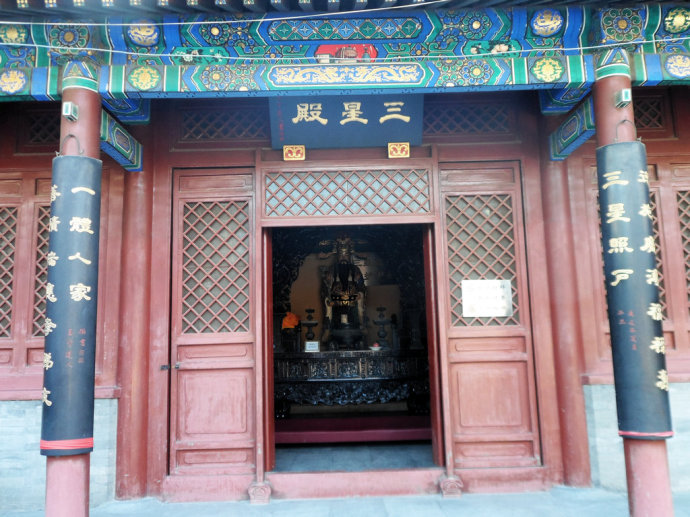 三星殿 殿内供奉福、禄、寿三位星君,中座为福星,西侧为禄星,东侧为寿星。福星护佑家庭和睦、幸福美满,禄星可保官运亨通、工作顺利,寿星能使健康长寿、安享天年。 San Xing Deity Hall Enshrined in this hall are three star deities, namely Fu Xing (Star of Auspiciousness) in the middle who blesses family in happiness and harmony, Lu Xing (Star of Official Rank) on the west who helps people to get a good job and achieve promotion, and Shou Xing (Star of Longevity) on the east who makes people in good health and long life. 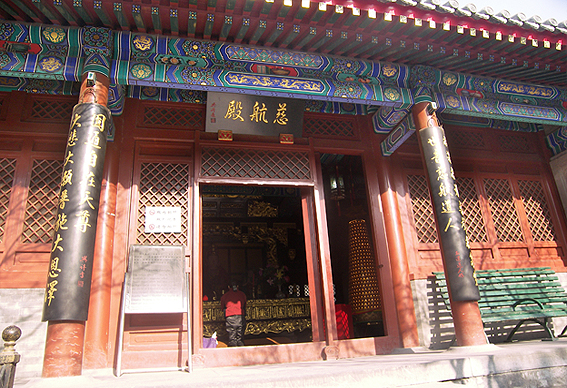 慈航殿 殿内供奉慈航普渡圆通自在天尊,又称观音大士,其神通广大,法力无边,大慈大悲,救苦救难,有求必应,普济世间苦难之人,圣诞为农历二月十九日。 Ci Hang Deity Hall Enshrined here is Tsihang Pudu Yuantong Zizai Tianzun (Goddess of The Benevolent Ship) who is called Guanyin Bodhisattva in Buddhism. Her sacred power is limitless, thus she can save all poor on the earth and never refuses to respond to a prayer. Her birthday is on February 19 of the lunar calendar. 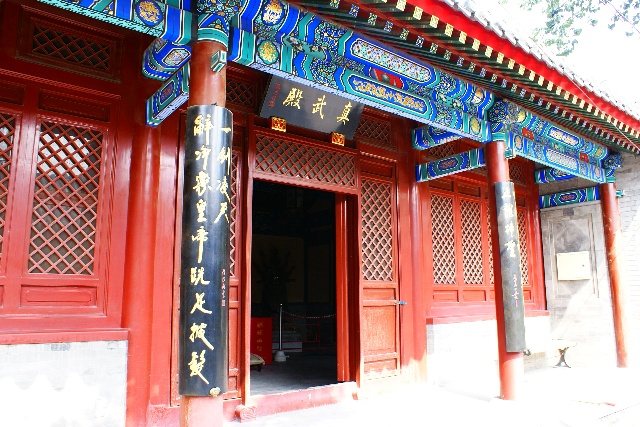 真武殿 殿内主供真武大帝,又称玄天上帝,原为净乐国太子,入武当修道,功成后位北宫协衡天道,佑善刑恶,护道降魔,庇护群生。两旁供天蓬、天佑两位天将。殿内神像皆为明代铜像。 真武大帝圣诞:农历三月初三日 Zhen Wu Deity Hall This deity hall mainly enshrines Zhenwu Celestial Lord who once was the prince of Jing Le Kingdom. He became a Celestial Lord after the completion of cultivating the Tao in Wudang Mountain. He helps the Jade Emperor to preside over the north of heaven. Often he protects the kindhearted people and is able to eliminate disasters for all living creatures. However he also carries out punishments upon bad people. The Celestial Generals standing beside him are called Tianpeng and Tianyou. The bronze statues were forged in Ming Dynasty. Zhenwu Celestial Lord’s birthday is on March 3 of the lunar calendar. 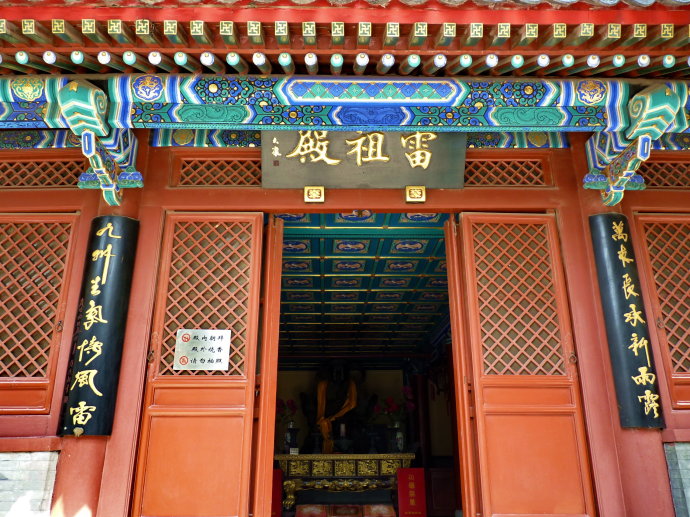 雷祖殿 建于明英宗正统三年(公元1438年),殿内供奉雷祖及风、雷、雨、电四位自然天神。雷祖圣号为九天应元雷声普化天尊,总司五雷,运行三界,主天之灾福,持物之权衡,掌物掌人,司生司杀。 雷祖圣诞:农历六月二十四日 Lei Zu Deity Hall It was built in the third Zheng Tong Year (1438A.D.) under the regime of Emperor Ying Zong in the Ming Dynasty. Enshrined here are Lei Zu (Ancestor of Thunder), Wind Deity, Rain Deity, Thunder Deity and Lightning Deity. Lei Zu is the president of the thunder department who controls life and death of all living creatures and supervises the heaven, the earth and the nether world. His birthday is on June 24 of the lunar calendar. 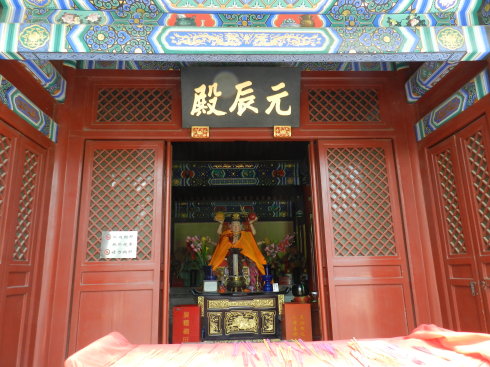 元辰殿 始建于金章宗明昌元年(公元1190年),殿内供奉斗姥元君与六十太岁神。斗姥为众星之母,掌管天上众星及世上凡人的簿籍,能为人消灾延寿。六十太岁分别为每个人出生之年的保护神,掌管人间功过福祸。中国古代以干支记年,如甲子年出生的人就属甲子年太岁保护,此神即为该人的保护神,又称本命元神。 斗姥天尊圣诞为农历九月初九日,又称九皇会。 Yuan Chen Deity Hall It was initially built in the first Mingchang Year (1190A.D.) under the regime of Emperor Zhang Zong in the Jin Dynasty. Enshrined here is Dou Mu Goddess and 60-Taisuis(60-Destiny Years Deities). Dou Mu is in charge of all the stars in the heaven and the people’s life on Earth. She can remove disasters and lengthen life for people. Taisui is the protector of a people’s journey of life. Since Xia Dynasty, people counted year, month and date by combining each of the ten Heavenly Stems with the twelve Earthly Branches in regular order, which formed a cycle of sixty. There are sixty deities for sixty years and each deity is on duty for one year. Everyone belongs to one deity of the year in which they were born. Dou Mu Goddess’s birthday is on September 9 of the lunar calendar. 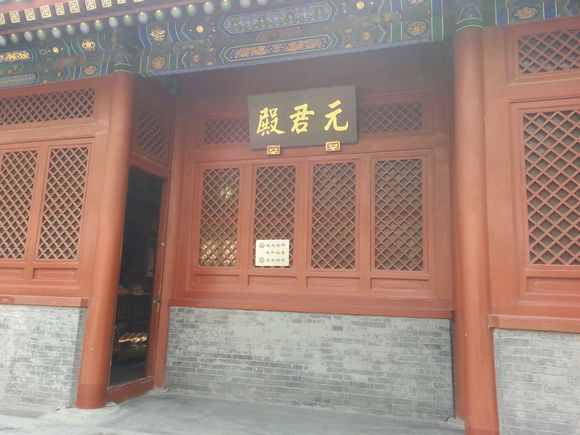 元君殿 建于清高宗乾隆二十一年(公元1756年),又称“娘娘殿”。中座供奉天仙圣母碧霞元君,左为送子娘娘和催生娘娘,右为眼光娘娘和天花娘娘,皆能保佑家庭和睦,婚姻美满,为妇女送子、助生,护佑小孩易养成人。 碧霞元君圣诞:农历四月十八日 Yuanjun Deity Hall This deity hall is also called Goddesses Hall, and was built in the twenty-first Qian Long year under the regime of Gao Zong Emperor in the Qing Dynasty (1756A.D.). The deity in the middle is Goddess Bixia Yuanjun who can bring lovers together, and blesses the family in peace and harmony. The Goddesses on the both side are Songzi, Cuishen, Yanguang and Tianhua, who are able to bring babies for devotees (help conception),help pregnant women to deliver their babies, and protect the children grow up healthily. Goddess Bixia Yuanjun’s birthday is on April 18 of the lunar calendar. 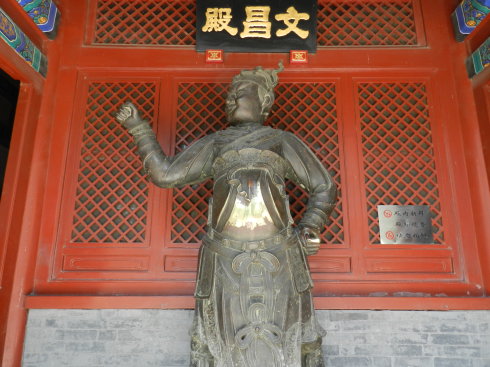 文昌殿 殿内供奉文昌梓潼帝君,两旁供孔子、朱熹及文昌帝君的侍神,殿外供魁星,皆为主宰人间功名禄位、读书考学之神。善信祈求,皆能开启智慧,金榜题名,一举夺魁。殿内神像为明代万历年间铜像。 文昌帝君圣诞:农历二月初三日 Wen Chang Deity Hall Inside this deity hall is enshrined Wen Chang Celestial Lord in the middle, with Confucius and Zhuxi and Celestial Attendants on both sides. The deity standing outside is Kuixing. They are protectors of scholars and students, and are able to bestow intelligence on people, and provide assistance to pass examinations and tests. The bronze statues were forged during Wanli Year in the Ming Dynasty. Wen Chang Celestial Lord’s birthday is on February 3 of the lunar calendar. 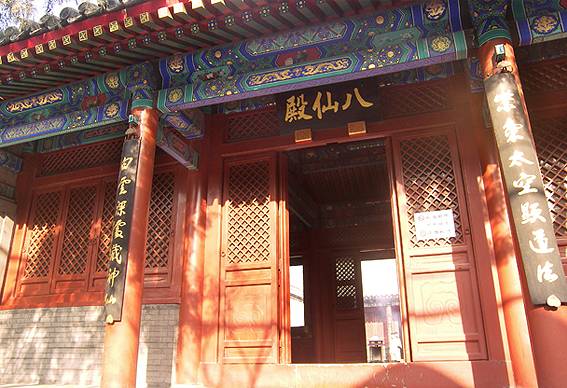 八仙殿 建于清嘉庆十三年(公元1808年),供奉道教八仙,即:钟离权、吕洞宾、张果老、曹国舅、李铁拐、韩湘子、蓝采和、何仙姑。他们代表了贫、富、美、丑、男、女、老、少等各种人物,是人人皆能成仙的例证。 Ba Xian Deity Hall It was built in the thirteenth Jia Qing Year (1808A.D.) in the Qing Dynasty. Enshrined here are Ba Xian (Eight Immortals), namely Zhong Liquan, Lv Dongbin, Zhang Guolao, Cao Guojiu, Li Tieguai, Han Xiangzi, Lan Caihe and He Xiangu. They represent the poor, rich, pretty, ugly, old, young, male and female, all types of people, which is proof that everyone has the potential to become immortal.  吕祖殿 始建于清德宗光绪十三年(公元1887年),供奉吕纯阳祖师。祖师名岩,字洞宾,号纯阳子,民间影响最大的八仙之一,得神仙之秘诀,誓愿普度天下众生,常为民除暴安良,斩妖伏魔,有求必应。 吕祖圣诞:农历四月十四日 Lv Zu Deity Hall It was initially built in the thirteenth Guangxu Year under the regime of Emperor Dezong in the Qing Dynasty (1887A.D.). Enshrined here is Lv Zu (Ancestor Lv) , who is the most popular deity in the Eight Immortals among the folks with his full name as Lv Dongbin. After mastering the key of Tao, he continues to save all living creatures, help kindhearted people, punish bad people, and combat evil spirits. He never refuses to respond to a prayer. His birthday is on April 14 of the lunar calendar. (责任编辑:admin) |
